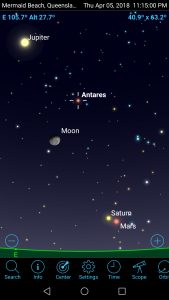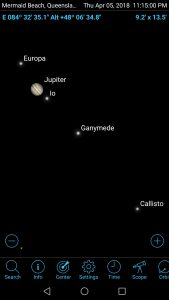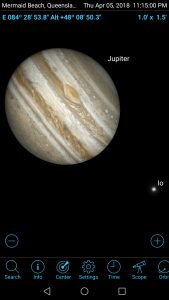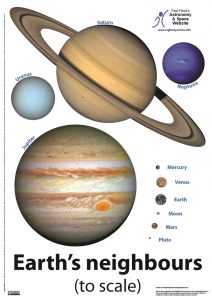(Posted 4 April 2018) Our evening sky ‘planet drought’ is finally over with the spectacular planets Jupiter and Saturn plus Mars visible. Yes, Venus is visible low on the Western horizon in evening twilight and has been for a while. But let’s face it, Venus is a featureless disc (strictly speaking a gibbous phase at present).

For those just starting out in astronomy, keep in mind that you don’t need a telescope to see Mars, Jupiter or Saturn. They just look like stars to the unaided eye (Jupiter being the brightest by far). You will need a telescope however to see the planets as discs.

If you do have binoculars or a small telescope, you will easily be able to see Jupiter’s largest moons (more information on the Galilean Moons). See above chart for Thursday night as an example.

Finally, if you do have a small telescope, you will be able to view the largest storm in the solar system, Jupiter’s Great Red Spot. It’s size varies but is usually given as 2.5 times the size of the Earth. Fortunately, no one has implemented a plan to move the Earth to test this size comparison!
The trick is knowing when to look at Jupiter to see the Great Red Spot. Jupiter rotates approximately every 9 hours and 56 minutes so when you need to look changes significantly. I use this site to tell me when to look.

Finally, feel free to download the above poster to give you a size comparison between various Solar System objects. Please ignore my old name. I have yet to update this poster. Also, if you want to see some amazing images being sent back from Jupiter now, visit NASA’s Juno probe website.